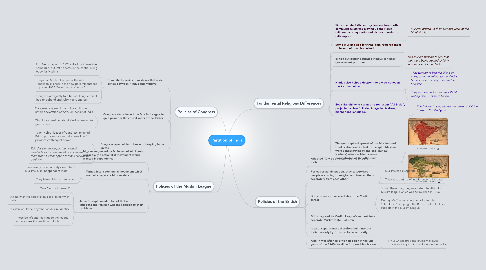
1. Policies of Congress
1.1. Commited a series of mistakes that widen divide between Hindus and Muslims
1.1.1. E.g. Nehru report of 1928 called for immediate home rule, but left no seats in the central ruling body for Muslims
1.1.2. Rejected Muslim League's offer of a coalition(alliance) in the new governments set up after 1935 Government of India Act
1.1.3. Congress arrogantly told Muslim League that it had to disband and submit to Congress
1.2. Congress also allowed the Muslim League to gain power in the crucial years of the 1940s
1.2.1. Congress resigned from politics following British declaration of WW2 on behalf of India
1.2.2. This 'lucky break' enabled Muslim League to gain power
1.3. Congress rejected last chance of keeping India united
1.3.1. 1946: Nehru, leader of Congress, rejected British proposals for an India based on 3 provinces with equal power
1.3.2. This decision made partition virtually inevitable as it made the Muslims realise that there was no other option for their survival but partition
2. Policies of the Muslim League
2.1. Muslim league led by Muhammed Ali Jinnah was initially a nationalist movement which wanted independence
2.2. Turned into a communal movement which wanted a separate Muslim state
2.2.1. There was growing anxiety over fate of Muslims in an Independent India
2.2.2. They feared Hindu domination
2.3. Jinnah's single minded belief that an independent Pakistan was the solution to their problems
2.3.1. "Divided or Destroyed"
2.3.2. Did not want to accept status as a 'minority' in India
2.3.3. Pakistan would be a symbol of Muslim identity
2.3.4. These beliefs and fears made the league actively seek the partition of India.
3. Fundamental Religious Differences
3.1. Since the late 19th century, leaders from both communities started playing up their own religion by using myths and history in order to rally support
3.1.1. Muslims played uo their glorious years of the Mughal rule
3.2. Some Muslims also felt that Islam required them to have their own homeland
3.3. British put better-educated Hindus in higher government positions
3.3.1. This caused Muslims to feel that they were being treated unfairly as compared to the Hindus
3.4. Hindus also helped deepen the divide between the 2 communities
3.4.1. They wanted to ban the killing of cows, a sacred animal to the Hindus but a source of cheap meat to the Muslims
3.4.2. They also wanted to change official writing from Persian to Hindu
3.5. Even Gandhi, who claimed to represent "All-India", projected a clear "Hindu" image in his dress, manner and language.
3.5.1. This helped to perpetuate the sense of division between the 2 religions
3.6. The geographical spread of the Muslims and Hindus also contributed to the split. Muslims were concentrated at one end( Bengal, Kashmir) whereas Hindus were concentrated at the other end.
3.6.1. Percentage of Hindus
3.6.2. Percentage of Muslims
4. Policies of the British
4.1. Adopted "Divide and Rule" Policy to govern India
4.2. For easier adminstration, they categorised people according to religion and treated them separately from each other
4.2.1. Muslims had a separate electorate
4.2.2. This caused sense of indifference to increase
4.3. British were also worried about the Muslim threat
4.3.1. To win them over, they supported the All-India Muslim league which was established in 1906.
4.3.2. During WW2, when congress adopted the "Quit India" campaign, the British had to look for support in the Muslim League
4.4. British agreed to Muslim League's request for a separate Muslim state -Pakistan
4.5. Idea of separateness therefore built into the Indian society by British colonial authority
4.6. Also, it was after all British decision in the vital years of the 1940s to allow for possible division
4.6.1. 1942: Cripps proposal crucially allowed provinces to opt out of an independent India
